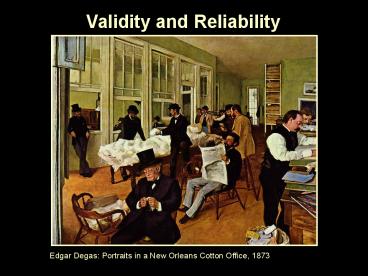Validity and Reliability - PowerPoint PPT Presentation
1 / 16
Title:
Validity and Reliability
Description:
Assessments of construct validity imply three types of hypotheses: ... [ Construct Validity] ... The measure of the construct might be invalid. ... – PowerPoint PPT presentation
Number of Views:2396
Avg rating:5.0/5.0
Title: Validity and Reliability
1
Validity and Reliability
Edgar Degas Portraits in a New Orleans Cotton
Office, 1873
2
Validity and Reliability A more complete
explanation of validity and reliability is
provided at the accompanying web page for this
topic. See Validity and Reliability
3
- Validity and Reliability
- Validity
- The extent to which a test measures what it is
supposed to measure. - Non-empirical evaluations.
- Empirical evaluations.
- Reliability
- The extent to which a test provides consistent
measurement. - Negatively affected by measurement error.
4
- Validity and Reliability
- Importance
- Without validity and reliability one cannot test
an hypothesis. - Without hypothesis testing, one cannot support a
theory. - Without a supported theory one cannot explain why
events occur. - Without adequate explanation one cannot develop
effective material and non-material technologies,
including programs designed for positive social
change.
5
- Validity
- Non-Empirical Validity
- Does the concept seem to measure what it is
supposed to measure? - This evaluation depends entirely upon the
intersubjective opinion of the community of
scholars. - It is not entirely subjective because it
represents the consensus opinion of many
subjective individual opinions.
6
- Validity
- Empirical
- Data analysis evaluation of validity.
- Does the concept predict another concept that it
is supposed to predict? - This evaluation depends upon empirical
evaluation, using either quantitative or
qualitative data. - Empirical validity does not imply content
validity.
7
- Validity
- Outcomes of Content Validity Assessment
- If the community of scholars approves the content
validity of a measure, then it is accepted for
further use. - If the community of scholars rejects the content
validity of a measure, then it must be redesigned
by the researcher(s).
8
- Validity
- Outcomes of Empirical Validity Assessment
- Assessments of construct validity imply three
types of hypotheses - Do the items used to measure the construct have a
statistically significant correlation with the
construct? Construct Validity - Does the construct have a statistically
significant correlation with related constructs?
Concurrent Validity - Does the construct statistically predict another
construct? Predictive Validity
9
- Validity
- Outcomes of Empirical Validity Assessment
- If the null hypotheses are rejected, then the
empirical results lend support for the empirical
validity of the measure. - If one or more null hypotheses are not rejected,
then - The measure of the construct might be invalid.
- The measure of the predicted construct might be
invalid. - The theory linking the two constructs might be
flawed.
10
- Reliability
- Measurement Error
- Measurement errors are random events that distort
the true measurement of a concept. - The average of all measurement errors is equal to
zero. - The distribution of measurement error is
incorporated within the standard error. - This distribution has the form of a bell-shaped
curve, identical to the distribution of the
standard deviation about a mean.
11
- Reliability
- Measurement Error and Hypothesis Testing
- With a small standard error, even a weak
relationship between the independent and
dependent variables can be judged as
statistically significant. - With a large standard error, even a strong
relationship between the independent and
dependent variables can be judged as not
statistically significant. - Therefore, it is important to reduce measurement
error as much as possible.
12
- Reliability
- Achieving Reliability
- Concepts must be defined as precisely as
possible. - Researchers must develop good indicators of these
concepts. This task sometimes requires much work
and time to create a valid and reliable measuring
instrument. - Data must be collected with as much care as
possible.
13
- Reliability
- Assessing Reliability
- Test-Retest Procedure.
- Advantages Intuitive appeal.
- Disadvantages History, Maturation, Cueing.
- Alternative Forms Procedure.
- Advantages Little cueing.
- Disadvantages History, Maturation.
14
- Reliability
- Assessing Reliability (Continued)
- Split-Halves Procedure.
- Advantages No History, Maturation, or Cueing.
- Disadvantages Different splits yield different
assessments of reliability. - Internal Consistency Procedure.
- Advantages No History, Maturation, or Cueing.
- Disadvantages Number of items can affect
assessment of reliability.
15
- Errors that Affect Validity and Reliability
- Measurement Error
- Random, but can be reduced with care.
- Sampling Error
- Errors in selecting a sample for study.
- Random Error
- Things that are unknown, unanticipated,
uncontrollable. - Data Analysis Errors
- Type-I False assumption of causality.
- Type-II False assumption of no causality.
16
Questions?































